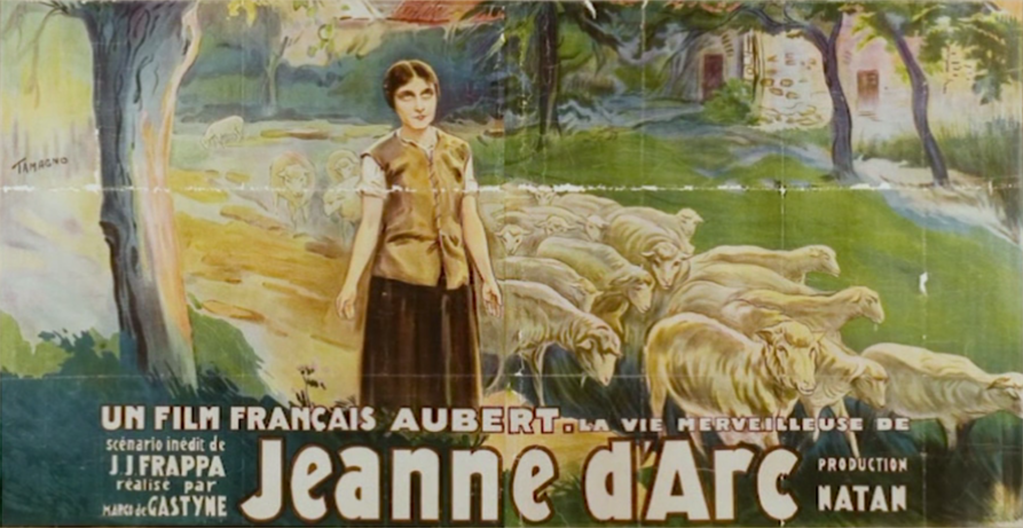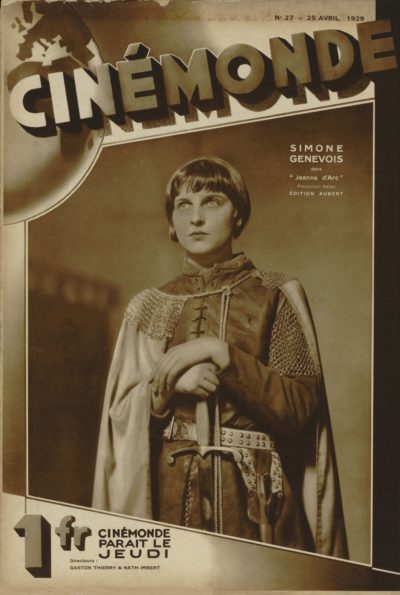 ★★★★
★★★★
“Merveilleuse is the word for it.”
 I generally make it a rule not to review foreign movies without subtitles, simply because it’s difficult to judge them reasonably if you can’t understand them. I made an exception for this 1929 French film for a couple of reasons. Firstly, it’s silent, so comprehension is limited only to the intertitles: I can read the language better than I can understand it spoken. Also, it was approximately the eleven millionth version of the Joan of Arc story I’d seen in the past month: I think I had a pretty good handle on the plot by this point. Boy, am I glad I did, because it’s the best silent film I’ve seen, albeit in my quite limited experience of them.
I generally make it a rule not to review foreign movies without subtitles, simply because it’s difficult to judge them reasonably if you can’t understand them. I made an exception for this 1929 French film for a couple of reasons. Firstly, it’s silent, so comprehension is limited only to the intertitles: I can read the language better than I can understand it spoken. Also, it was approximately the eleven millionth version of the Joan of Arc story I’d seen in the past month: I think I had a pretty good handle on the plot by this point. Boy, am I glad I did, because it’s the best silent film I’ve seen, albeit in my quite limited experience of them.
 History has largely forgotten this version, in favour of Carl Theodor Dreyer’s La Passion de Jeanne d’Arc. Both movies were produced concurrently, interest in the topic apparently having been spurred by the canonization of Joan at the start of the twenties, and the approaching 500th anniversary of the events in her life. However, delays during filming meant this adaptation was beaten to the cinema by Dreyer’s. It perhaps was also impacted commercially by the arrival of the new-fangled “talkies”, leaving silent movies like this looking old-fashioned. Half a century later, the film was eventually restored, and can be found on YouTube as well as the Internet Archive.
History has largely forgotten this version, in favour of Carl Theodor Dreyer’s La Passion de Jeanne d’Arc. Both movies were produced concurrently, interest in the topic apparently having been spurred by the canonization of Joan at the start of the twenties, and the approaching 500th anniversary of the events in her life. However, delays during filming meant this adaptation was beaten to the cinema by Dreyer’s. It perhaps was also impacted commercially by the arrival of the new-fangled “talkies”, leaving silent movies like this looking old-fashioned. Half a century later, the film was eventually restored, and can be found on YouTube as well as the Internet Archive.
At over two hours long, it’s certainly epic, yet is almost constantly engrossing. Its main strength is Genevois in the role of Joan, who has an incredibly impressive face, which more than counters the lack of dialogue. She was only 15 when the film went into production, but already had a decade of experience in making films, including another silent epic, Abel Gance’s Napoleon. It was quite a stressful production, with the actress enduring heavy costumery. She said, “They made me a very light suit of armour, but I ended up with real armour. At the Battle of Orleans I had to wear a 22-kilo suit of chain mail. As soon as I finished a scene, they would lay me down and I would sleep on the ground because I couldn’t take the weight.”
Those battle scenes are extraordinary, especially for the time, overcoming the constraints of the 4:3 aspect ratio. The siege at Tourelles is a phenomenal set piece, involving 8,000 extras, largely recruited from the French army. There’s additional poignancy to the spectacle, Joan realizing the horrors of the battlefield, which have been unleashed as a result of her actions. While I’ve yet to see the Dreyer version (by most accounts, it seems rather talky for a silent!), it’s hard to imagine anyone improving on Genevois’s performance. Inevitably, things do become a bit of a slog during the trial; the dialogue heavy nature of those scenes are always going to be tough. Yet even here, there are moments of exquisite beauty; Joan sat, her head bowed, as her accusers file out past her.
 Then there’s the burning at the stake, another scene which came uncomfortably close to historical accuracy for Genevois. “The moment the wood caught fire I yelled ‘It burns!’ [The director] Marco was so sure I was afraid, that he did nothing at all. All of a sudden the cameraman, Gaston Brun, shouted ‘She’s burning!’ and everyone ran towards me, because I was tied up and couldn’t budge. I was very frightened.” Even putting that aside, there’s no denying the emotional wallop it packs, particularly in the extended shot of Joan walking towards her death: Simone’s face, again, sells this in a way which left me genuinely distraught. This doesn’t happen often, and never before while watching any silent movie.
Then there’s the burning at the stake, another scene which came uncomfortably close to historical accuracy for Genevois. “The moment the wood caught fire I yelled ‘It burns!’ [The director] Marco was so sure I was afraid, that he did nothing at all. All of a sudden the cameraman, Gaston Brun, shouted ‘She’s burning!’ and everyone ran towards me, because I was tied up and couldn’t budge. I was very frightened.” Even putting that aside, there’s no denying the emotional wallop it packs, particularly in the extended shot of Joan walking towards her death: Simone’s face, again, sells this in a way which left me genuinely distraught. This doesn’t happen often, and never before while watching any silent movie.
de Gastyme then simply stops the film. It’d seem an abrupt ending almost anywhere else; here, it acts as a force-multiplier for Joan’s death, letting it resonate in the silent darkness which follows. Finally, I have to give credit to the sadly unknown composer who provided the score accompanying the movie. It’s top-tier stuff, complementing and enhancing the on-screen action to great effect, whether rousing the blood during the battles, soaring to the heavens for her visions, or mourning the inevitable fate of the heroine. Over its 125 minutes, this hits all the expected moments with precision, and Genevois – who retired from movies at the ripe old age of 23! – deserves to be far better-known in ranks of actresses to have taken on the iconic role of Joan.
Dir: Marco de Gastyne
Star: Simone Genevois, Fernand Mailly, Georges Paulais, Jean Debucourt
a.k.a. Saint Joan the Maid




